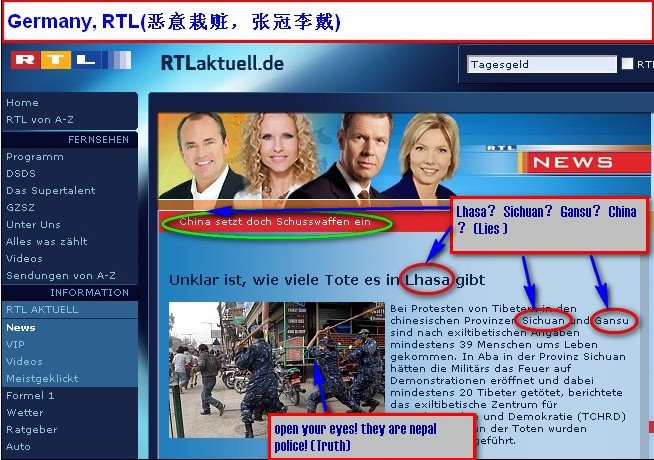Germany's RTL television said on Sunday that it "regrets an error" in covering the riots in Lhasa, capital city of China's Tibet Autonomous Region. (Related: Lhasa riot reports show Western media bias)
[ Video]
Video]
The TV station admitted on its website that it "used a picture in a wrong context."
In fact, the picture shows security forces in Nepal, a neighboring country of China, RTL said in an online statement.
"The image was taken on March 17 in the capital city of Kathmandu, where Nepalese security forces were confronting demonstrators with batons," it said.

"We have accidentally created the impression that it is a scene of the unrest in Tibet with Chinese security forces involved. We regret this error," the statement added.
The RTL Aktuell, a main news program of the RTL TV, along with the German Bild newspaper and the Washington Post, have been found using on their websites pictures of baton-wielding Nepalese police in clashes with protesters in Kathmandu, claiming that the officers were Chinese police.
They were among those Western media that have been condemned by netizens in the past few days for distorting facts in covering the riots in Lhasa.
CNN has posted a picture on its website showing people running in front of a military truck. The original picture uploaded by Chinese netizens, however, also shows mobsters throwing stones at the truck.
The British Broadcasting Corporation (BBC) released a picture on its website showing China's armed police officers helping medical staff move a wounded person into an ambulance.
The website's caption said that "there is a heavy military presence in Lhasa," neglecting obvious "First Aid" and red cross signs on the ambulance.
The German newspaper Berliner Morgenpost posted a picture on its website in which police in Lhasa rescued a young man of Han nationality assaulted by rioters. But the caption distorted the fact as "insurrectionist taken away by police".
Fox TV said in a picture's caption on its website that the Chinese military dragged some protesters onto a vehicle but actually the uniformed people were Indian police.
(Xinhua News Agency March 24, 2008)